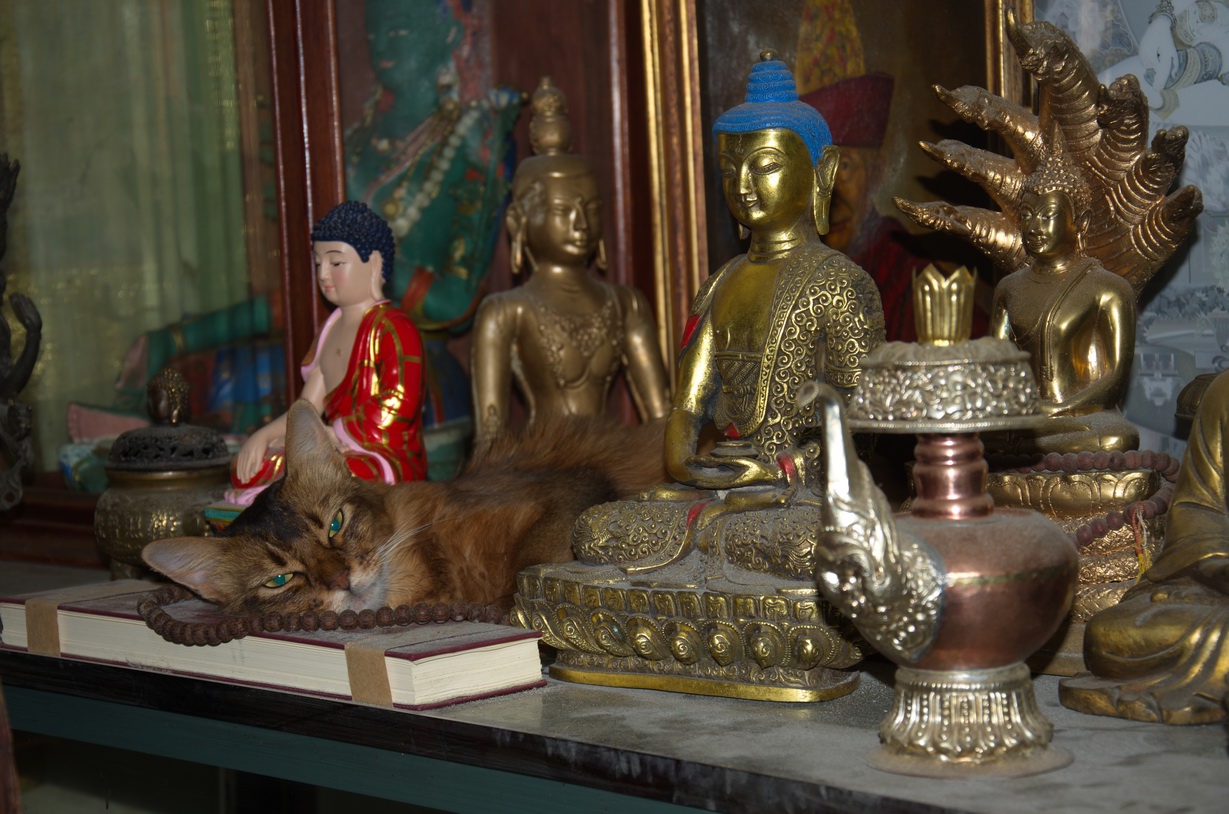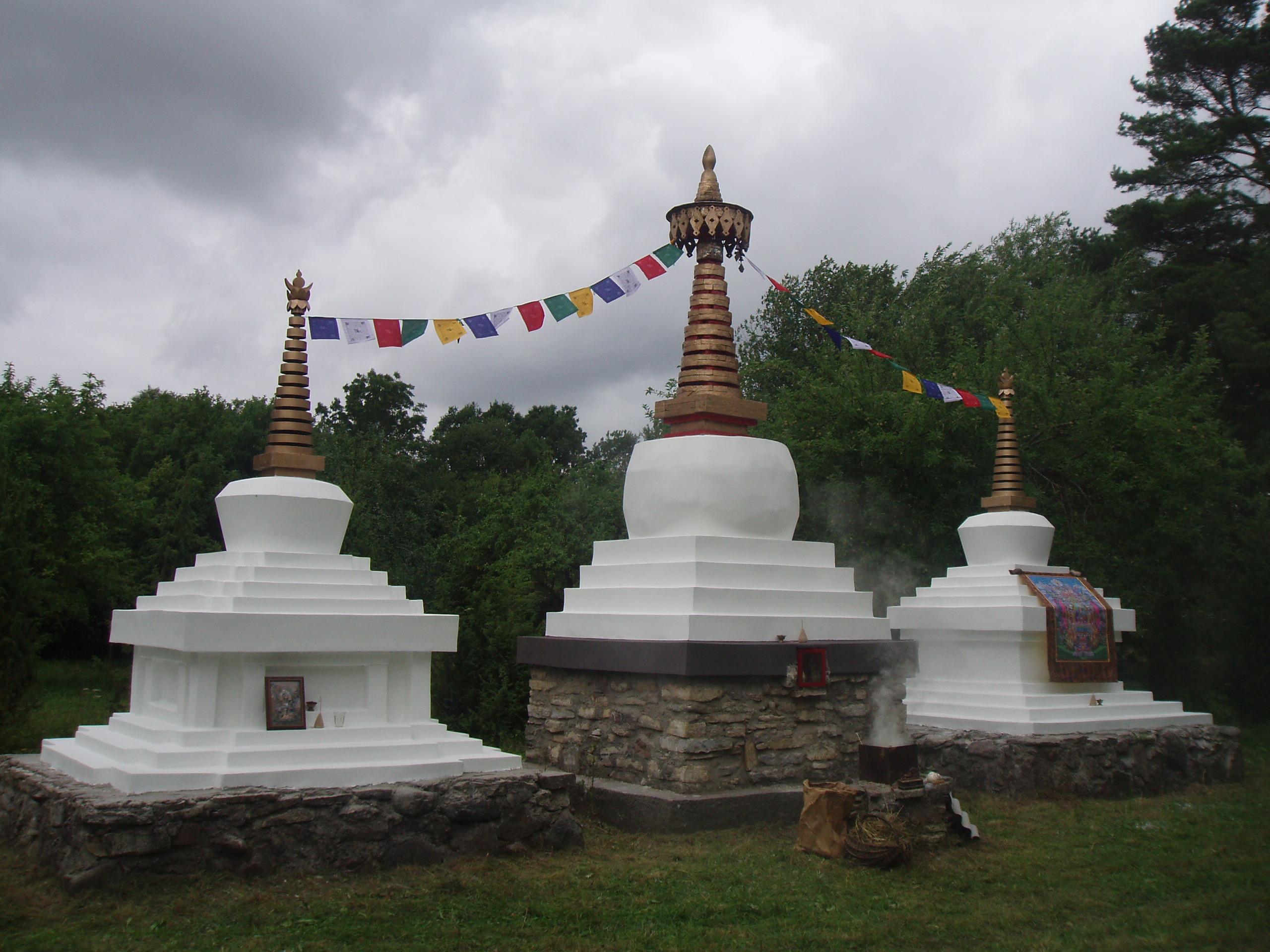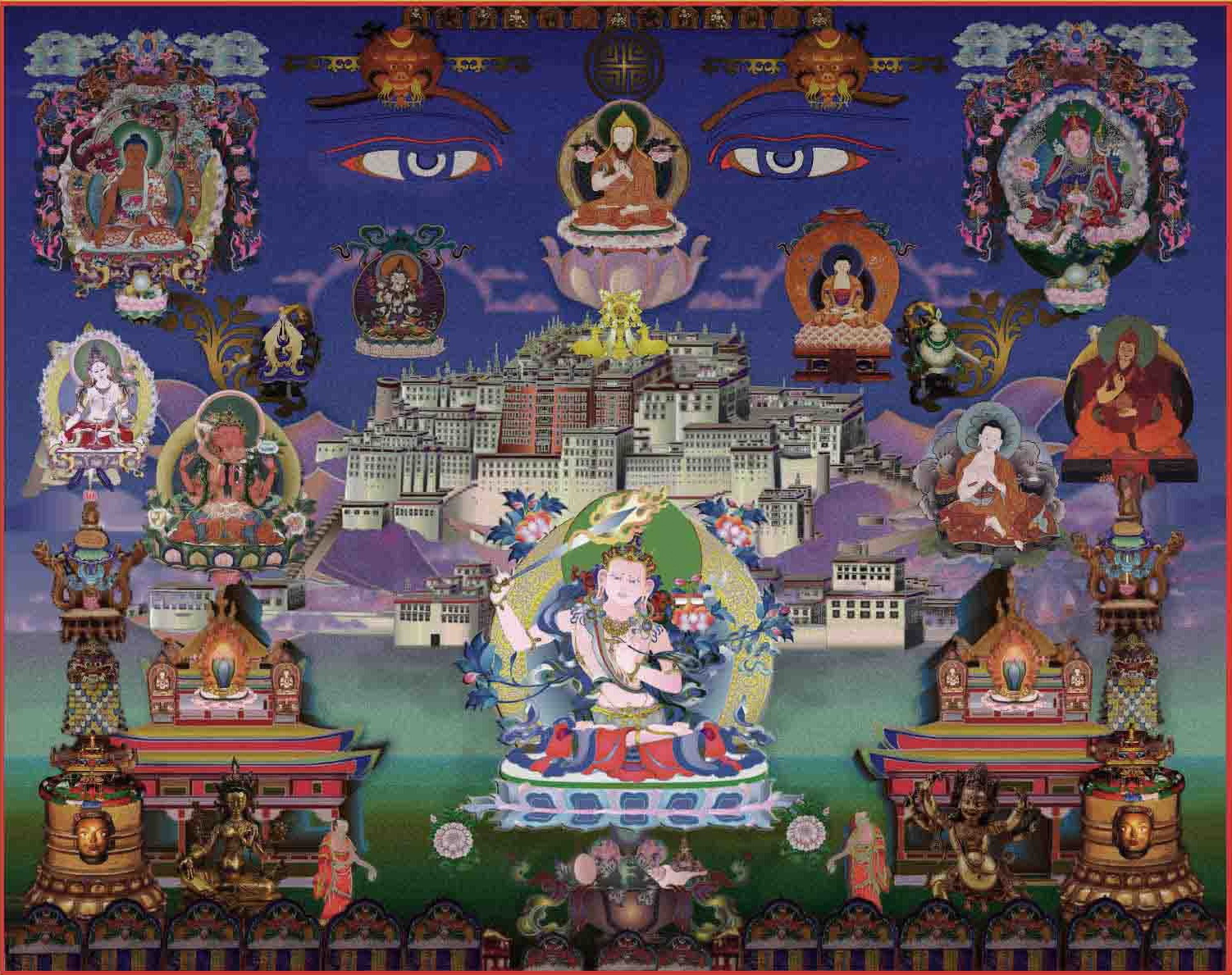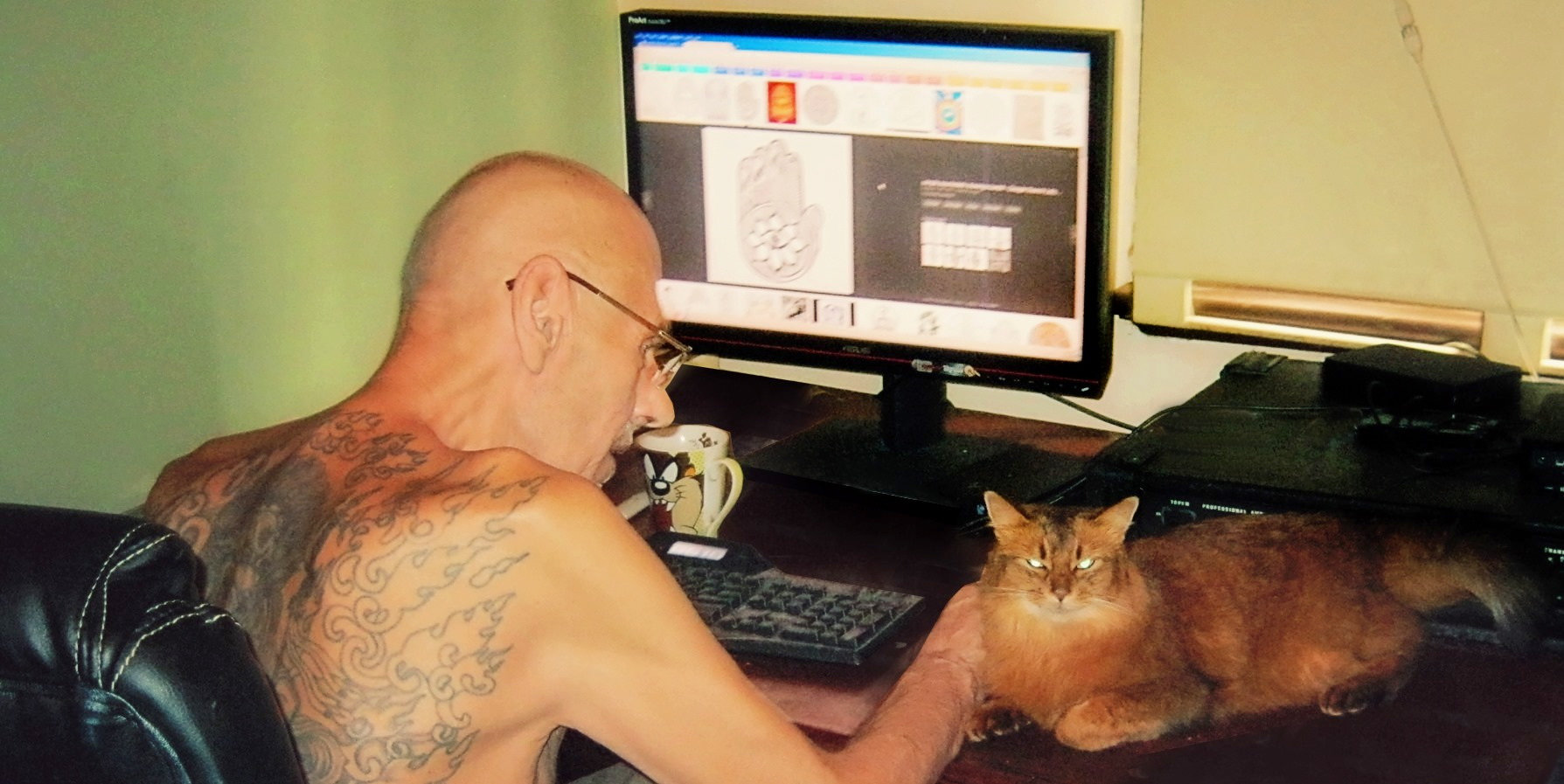Buddhistdoor Global (BDG): You’ve been living in Australia for some decades now. But you have also spent many years building stupas, 8 of them by yourself, and created original thangkas. How did you balance so many projects with your teaching and practice in Australia?
Vello Vaartnou (VV): For me, the stupa is a cosmic symbol. It represents a 3D mandala, and as my Guru Munko lama said – it is a direct connection to Shambhala. Classically stupa (in Pali literally meaning “heap”) is a mound-like structure containing Buddhist relics, typically the ashes of deceased, used by Buddhists as an object of meditation. My Guru`s explanation is different and I like his version. It gives a new perspective for Kalachakra as well, as stupas are like cosmic antennas.
When I built my last stupa in Estonia, something extraordinary happened: one night, it seemed as if it was on fire. My friend, who was there with me at the time, went out to take a closer look and when we were 5 meters from stupa, it disappeared. Three days later another friend came to see me, and again at night time he told me that stupa was shooting towards the heaven some kind of large blue bubbles.
They were the same size as the stupa base and very bright, with eight witnesses. The stupa is still in Estonia, but now it is quiet. No bubbles, no fire anymore. It happened just when I finished the dedication ritual to the deity of stupa. I have asked around different lamas who have built stupas and they didn’t know what to say about this. Now I feel that I have to build more stupas because this connection with Shambhala may be useful!
Thangkas are easy. I just meditate and I see them. The Bhutanese king’s uncle visited me once, and said that they were not real thangkas. Perhaps he is right, but as I see it, most thangkas are just copied from others anyway, and nobody wants to sit down and meditate for a week. Probably they think it is a waste of time. In my case, I see thangkas all the time but I don’t have time to make them because the Chinese Buddhist Encyclopedia takes up my schedule.
I do not teach so much. I prefer disseminating philosophy, the Buddhist worldview, psychology, rituals, and so on.
When I built my last stupa in Estonia, something extraordinary happened: one night, it seemed as if it was on fire. My friend, who was there with me at the time, went out to take a closer look and when we were 5 meters from stupa, it disappeared. Three days later another friend came to see me, and again at night time he told me that stupa was shooting towards the heaven some kind of large blue bubbles.

They were the same size as the stupa base and very bright, with eight witnesses. The stupa is still in Estonia, but now it is quiet. No bubbles, no fire anymore. It happened just when I finished the dedication ritual to the deity of stupa. I have asked around different lamas who have built stupas and they didn’t know what to say about this. Now I feel that I have to build more stupas because this connection with Shambhala may be useful!
Thangkas are easy. I just meditate and I see them. The Bhutanese king’s uncle visited me once, and said that they were not real thangkas. Perhaps he is right, but as I see it, most thangkas are just copied from others anyway, and nobody wants to sit down and meditate for a week. Probably they think it is a waste of time. In my case, I see thangkas all the time but I don’t have time to make them because the Chinese Buddhist Encyclopedia takes up my schedule.
I do not teach so much. I prefer disseminating philosophy, the Buddhist worldview, psychology, rituals, and so on.
BDG: You were able to bring great benefit to Estonia by propagating Buddhism there for years. Can you share with our readers your perspective on Estonian religious interests and practice, as well as the present situation of Buddhism there?

VV: I haven’t been back to Estonia for 10 years, so it is hard to say. In our days everybody was interested in Atiyoga or Dzogchen. My opinion is that you have to be better prepared to get into Dzogchen. As far as I know, Kagyu is quite popular in Estonia, and there is some Nyingma and of course Dzogchen. I am, of course, always happy about how we established the Estonian Buddhist Brotherhood. It was the first group I established.
Many books in were translated about Tibetan Buddhism. I studied Gelug but I have always counted myself as Nyingma. In Ivolga monastery, there were jokes about Nyingma spies in the Gelug monastery. Now my Guru has passed and I hope he has reached Pemakö. He was a doctor lama and he tried to turn my interest toward medicine. I was not so bright because I didn’t want to be bright in medicine. I was interested in philosophy. Guru told me that philosophy cannot heal the body, while I said that the mind is more important than the body. At the end he understood that it was meaningless for me to deal with Tibetan medicine.
We, the Estonian Buddhist Brotherhood, built the first stupas in Northern Europe.It was called Brotherhood but actually we had more women members who helped with translations, for example Anu Rootalu who is a Tibetan medicine doctor now. I guess it was a nice start for Buddhism in Estonia, all Brotherhood members visited the Ivolga monastery, where I studied. It was a happy time for me.
BDG: Your CBE has grown greatly since 2012. You have made many entries and the CBE will be very helpful in helping more people around the world to understand Chinese Buddhism. What is the future direction would you like to take it?

VV: At first I made a little encyclopedia about Buddhism in Estonian, it is very small, a few thousand words. When I was doing this encyclopedia, it came to my mind that Estonia is such a small country, I could do something bigger. When I went to Australia I decided to start a new and bigger project and it was, or it is Chinese Buddhist Encyclopedia. At the beginning everything looked bright, I was in China, talking to people and many promised to help. I started encyclopedia with one friend, but since I have been doing it alone. Everybody said it was too big a project. Professor Lewis Lancaster from Berkeley University was the first person to support my project. I made the announcement about CBE in Berkeley.
Tibet and China have very different cultures. Yet events last century stimulated Chinese interest in Tibetan Buddhism. Tibetans began to occupy Chinese cultural territory. In China I met a lot of people who said that they have a Tibetan lama as a guru. The first person I met about in Beijing was Kunkun Duan. She was a devout lady who supported me a good deal in the early stages. I eventually understood that there was a place for Tibetan Buddhism in the Chinese Buddhist Encyclopedia must have a place for Tibetan Buddhism.

The first thought to use Chinese Buddhist Encyclopedia as a base for Tibetan Buddhism began in Estonia. My problem is that I am alone, working 18 hours per day, sometimes two days in a row. At the beginning there were many volunteers, but they disappeared fast. So I have been doing it alone for four years. I have asked around the world computer programmers to help with scripts what I use in CBE but until now no one has responded, except my friend Eugene Rossin in Stockholm who has dedicated a lot of time for CBE. Nevertheless, I cannot rely solely on him. As a Tibetan Buddhist myself I started from Tibetan Buddhism in CBE. When I was in China and Drepong in India I called the monastery about the CBE. They started to shout at me: “How you could do this when you are Tibetan Buddhist?” I hung up, understanding there was no point in continuing the conversation.
This will be my lifetime project. I do feel sad that no one seems willing to support this project. I have to pay for the servers and all other costs by myself. As I mentioned, at the beginning Kunkun Duan and his friends helped me a lot. But for the rest of the time, it has been my sole endeavour.
Interestingly, I just came to Stockholm and tried to contact different government and non-profit organisations in regards to living space and my work with CBE. I wrote to 68 officials and even to the Catholic diocese, and did not get any response. Even the Swedish Royal Academy of Science didn’t pay any attention: nobody answered, no one showed interest in CBE.
At the same time many universities all over the world have shown their support. As Sweden is a Christian country, Swedes might not know about China, and are not interested in Chinese culture. When I was in China people were amazed that a Swedish person was making the CBE. I didn’t tell them that I was more Estonian than Swedish. People often asked where I was from, and my answer was Sweden, so I am always Swedish. But it seems that Sweden doesn’t care about China or CBE, it is sad.
I am therefore seeking any dana-minded sponsors to be able to provide me with a modest living space where I can devote more time and efforts to helping CBE reach its full potential. Sponsors who see the value in CBE and might be willing to contribute to its upkeep would be very much appreciated as well.
BDG: How do you see the socio-religious landscape of religion in Australia today?
VV: I lived in Perth, where the Buddhists there are familiar with Ajahn Brahm, I know him too. I think he has done amazing work to build a Buddhist monastery in Christian country. It means that Theravada influence is quite strong I guess. I’ve visited the monastery, where it is popular among Australians of different ethnic backgrounds.
We will see how Buddhism develops in Australia. I left because my Chinese doctors said that if I wanted to live longer I had to move to a cooler climate. Now I am back in Stockholm. I live in my friend’s apartment and I have 6 square meters to use. For me and for my computer it is enough, but I have a huge amount of books and some manuscripts. For them I need at least one small room. Most importantly, I have Marju Broder as a secretary and she has done so much to help. Her work is always connected to mine. She even takes part in the Berkeley conferences with her own presentations. She is a very smart Buddhist. I can’t imagine my work without her.
BDG: Can you share some blessings and New Years’ wishes for what has been a difficult start to 2020 in Australia due to the forest fires?VV: In the Year of 2020, the Metallic Rat: We all know the story of the rat and Jade Emperor. The supreme Daoist deity held a race to decide the animals of the Chinese astrological calendar. The Rat tricked the Ox into giving him a ride. Then, just as they arrived at the finish line, Rat jumped down and landed ahead of Ox, becoming first. That is the nature of the Rat. They are able to turn unlucky events into fortune. Let us hope we can do the same thing this year.
VV: I wish happiness to each house, to each person, each living being here in samsara. No war, no suffering. And for ourselves, the most important thing in our life: to encounter and practice the teachings of the Buddha.


salute you 🙂